Contents
- Types of corns
- Hardware pedicure for callus removal
- Cryodestruction of calluses
- Removal of corns with a laser
- Electrocoagulation of calluses on the leg
- Radio wave method for removing calluses
- Surgical excision of calluses
- Medical treatment of corns
- When should you see a doctor?
- Which doctor deals with the removal of corns?
- Prevention of calluses on the feet
A callus is a thickening of the skin on the soles of the feet. Calluses occur due to excessive pressure on the foot or its frequent friction. Corns can be dry or wet. Most often, dry corns with a stem, which are a coarsened area of the skin, require removal. In the center of the callus, under the keratinized dermis, there is a hard root, which can cause pain while walking.
Types of corns
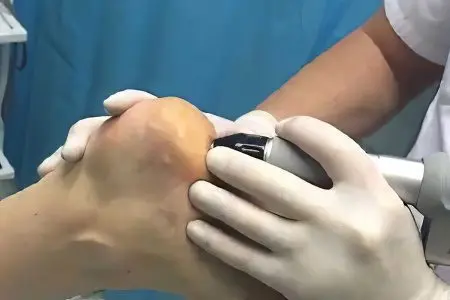
Callus on the feet not only does not look aesthetically pleasing, it is capable of delivering a lot of inconvenience to its owner. Some calluses are painful and can become inflamed and fester.
Depending on the structure of the corn and the reason for its appearance, the following types of skin growths are distinguished:
Dry skin callus. It is a compacted superficial layer of the skin, which in appearance resembles a yellow nodule. It looks like a wedge that goes deep into the foot. Such calluses can appear on the toes as well as on the soles. Their formation leads to the wearing of uncomfortable shoes and violations of the rules of foot care. Skin calluses can hurt, the pain becomes especially intense while walking.
Wet corn. Such a corn looks like a bubble that is filled with liquid. Bubbles hurt, provoke the appearance of a burning sensation. If you properly care for such a corn, then it will pass on its own, after a short period of time. However, if you continue to put pressure on it and injure it, then the wet callus will become hard.
A hard callus appears when prolonged friction and pressure is applied to the skin. Such corns are grayish or yellow in color, can crack and hurt. The corn has a conical shape, the peak of the cone is directed towards the sole.
Callus most often appears in the spaces between the toes, as well as on the soles of the feet. In the center of the callus there is a rod that goes deep into the skin. It is very difficult to remove such a rod on your own; the help of a specialist is required. The rod while walking can cause severe pain.
Calluses are hard calluses that cover a large area of the skin. Most often they are localized on the soles of the feet.
It is not always possible to cope with corns with conservative methods. In case of violation of the blood supply and innervation of the leg in the area of the callus, its removal is required. In this case, they resort to such methods as: cryodestruction, laser removal, electrocoagulation, radio wave method, surgical excision.
As a rule, the help of a specialist is required for people with hard skin corns, with corns and calluses. They are removed by pedicure masters in beauty salons, or dermatologists. If a person has foot deformities, then he needs the help of an orthopedist.
Hardware pedicure for callus removal
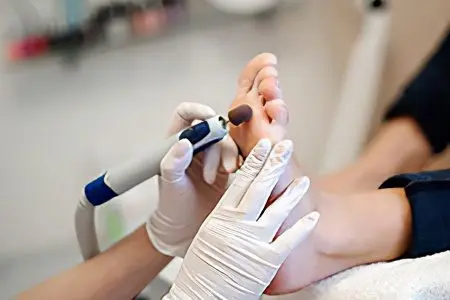
You can get rid of corns and even corns with the help of a hardware pedicure procedure. Some experts offer manual removal of corns with scissors and a scalpel, but this treatment is very painful and not every person can withstand it.
Hardware manicure comes down to drilling out corns using burs with different notches. The speed of the drill should not exceed 7000 rpm. The master removes not only the corn itself, but also cuts off the rough skin that surrounds it. If the corn is old, then it is not always possible to get rid of it in one procedure.
Stages of removal of callus during the hardware pedicure procedure:
With the help of an antiseptic solution, the hands of the master and the feet of the client are treated.
The master palpates a rough formation, which has a rounded shape and a root in the center. After determining the work area, it is treated with a sand cap with a large abrasive applied to it.
The corn is drilled with a round burr at low speed. The movements of the master must be point.
If the corn is deep and old, then the master will use a softener, which will speed up the process of getting rid of the corn.
When the skin becomes softer, it is removed with a pusher.
To remove the corn core, the master will use a round bur having a small diameter. The procedure is carried out until the person feels a prick.
The final stage of treatment is grinding the skin around the callus with a finely abrasive sand cap. Then the affected area is sealed with a plaster.
When the callus is deep and the patient has an increased pain threshold, anesthesia may be performed. For this purpose, use sprays or creams that have an analgesic effect. As a rule, to fully get rid of corns, you need to complete a course consisting of 3-6 procedures.
Hardware pedicure allows you to get rid of not only calluses, but also corns. To remove them, the skin is softened, and then treated with conventional polishing. Already after the first procedure, the dermis will become smooth, even and pleasant to the touch.
Advantages of removing corns with a hardware pedicure:
If the master observes the technique of the procedure, then it is safe. The use of special nozzles helps to avoid injuries and cuts.
When using disposable nozzles and with proper antiseptic treatment, the risk of infection is minimal.
The procedure is not accompanied by pain. If a person has any concerns, then you can ask the master to anesthetize the treated area.
The effect remains for a long time. Subsequently, the pedicure procedure can be done less frequently. In order for the effect to last for a long time, you need to carefully care for your feet, wear properly selected shoes and use moisturizing creams.
In the process of removing corns, healthy skin does not suffer.
The procedure can be performed for people with varicose veins and diabetes.
Cons of hardware manicure for removing corns:
The cost of the procedure is high. It starts from 2500 rubles and above. For a full treatment course, you will have to pay an impressive amount.
Not always masters are professionals in their field. Unskilled actions of the master can harm the patient. Therefore, you need to contact only specialists with specialized education. Remember that only a podiatrist can perform a medical pedicure.
If you do not eliminate the cause of the appearance of corns, for example, continue to wear uncomfortable shoes, then a hardware pedicure will need to be done often.
Cryodestruction of calluses

Cryosurgery of corns is a procedure aimed at the destruction and removal of growths on the soles and toes. Perform the procedure by treating the corn with liquid nitrogen.
It is necessary to influence the cold not only on the corn itself, but also on its core. If it is not treated, and only the stratum corneum is removed, the patient will continue to suffer from pain while walking. Freeze the corn for 30 seconds. Cryonecrosis is formed at the treatment site. After 2 weeks, it is rejected, and new young skin appears in its place. So that during this period a callus does not form again at the site of exposure to liquid nitrogen, it is necessary to protect the skin of the foot with a patch.
The progress of the procedure for removing calluses by cryodestruction:
A person is laid on a table and the corn is treated with liquid nitrogen.
Since the skin is frozen, the patient does not experience pain. The procedure can be performed without the use of anesthesia.
Tissues that have been exposed to liquid nitrogen die, so the doctor removes them.
The treatment procedure ends with the treatment of the wound with a disinfectant and the application of a bandage.
Nitrogen is odorless and colorless, it looks like a clear liquid. The procedure takes from 30 seconds to 2 minutes. Nitrogen comes from a special apparatus, thanks to which the doctor has the opportunity to act on the corn pointwise. Immediately after the procedure, a bubble filled with liquid will appear at the treatment site. Then it dries and becomes covered with a dense crust. Diseased cells will die off for another 10-14 days. After the crust leaves, young healthy skin will appear in place of the corn. In order for the healing process to go faster, the crust must be treated with Fukortsin. Be sure to follow the hygiene of the feet. In order not to mechanically damage the place of a cold burn, you need to seal it with a plaster. It is forbidden to pierce the bubble, or tear off the crust. This can lead to the fact that an infection gets into the wound, and after it heals, a scar will remain on the dermis.
The advantages of cryodestruction of calluses on the legs include:
The procedure is painless, during the treatment of the skin with liquid nitrogen, a person may experience slight discomfort, but it is not so intense that the patient needs anesthesia.
In time, cryodestruction of the corn does not take more than 2 minutes.
The tissues surrounding the callus will not be injured.
The risk of infection with proper procedure is minimal.
The method has no age restrictions.
Cryodestruction is not a very expensive procedure. Prices for its implementation start from 700 rubles.
As for the minuses of cryodestruction, they include a long rehabilitation period. For 10-14 days, a person will experience discomfort while walking. This is especially true for the first 2 days, until the bubble bursts. Therefore, with the help of liquid nitrogen, it is not recommended to remove large calluses that occupy large areas on the foot. Wounds like this take too long to heal.
Removal of corns with a laser

Laser removal of corns is one of the most effective ways to deal with skin growths.
The procedure takes place in several stages:
A person is laid on a couch, the treatment site is disinfected and an injection with an anesthetic is given.
The corn is exposed to a laser beam. The skin tissue is evaporated. The dermis that has turned into a clot will be manually removed by the doctor. Manipulation is performed using tweezers.
In the place where there was previously a corn, a wound is formed. The doctor treats it with an antiseptic and seals it with a band-aid.
At home, you will need to apply a disinfectant to the wound every day until it is completely healed.
A person will be able to move without problems immediately after the procedure. However, for several weeks after the removal of the corn with a laser, you should stop wearing tight and uncomfortable shoes, and also do not visit the steam room, sauna, bath. Most often, the crust that appears at the site of the removed callus falls off on its own on the 7-10th day. You should not try to tear it off, or wet it, as this can lead to infection of the wound and the formation of scar tissue.
The advantages of laser corn removal include:
The treatment process does not take much time. It takes no more than 10 minutes to remove one callus.
A person can step on a sore leg immediately after the procedure.
Cauterization of corns with a laser will not provoke the development of bleeding. All small capillaries instantly coagulate, as they are exposed to high temperatures.
The chance of wound infection is minimal.
The corn can be removed in one procedure.
The tissues of the soles of the feet will quickly recover.
After treatment of the corn with a laser, there are no scars or scars on the skin.
The procedure for removing corns with a laser has a number of contraindications, including:
Decompensated diabetes mellitus.
Immunodeficiency.
Pregnancy.
Cancers in the body.
Herpes in the acute stage.
Inflammation of the skin in the treatment area.
Menstrual bleeding.
During the procedure, healthy areas of the skin are not affected. The specialist has the ability to control the depth of penetration of the laser. The result is stable over time, provided that the person follows medical recommendations.
Electrocoagulation of calluses on the leg

Electrocoagulation of corns involves the destruction of the skin growth with the help of an electric current. During the procedure, it is possible not only to remove the corn, but also to ensure cauterization of the vessels.
The procedure has a number of contraindications, including:
Individual intolerance to the effects of current on the body.
Arrhythmia.
Hypertension.
Angina pectoris.
Increased body temperature.
The presence of a pacemaker in the human body.
The procedure is fast, it does not take more than 2 minutes. Before exposure, the treatment area must not only be disinfected, but also anesthetized. Burning of corns is carried out using a special loop that emits high-frequency currents. After cutting the tissues of the callus, the doctor treats the skin with a solution of potassium permanganate and seals the wound with a plaster. At home, it can be removed so that the crust formed on the surface of the sole is in the fresh air. After about 8-10 days, it will fall off on its own. During this time, healthy young skin will form under the crust.
The advantages of the procedure include:
The corn can be removed in one visit to the doctor’s office.
The procedure does not take much time.
The tissues heal quickly.
No preparatory procedures are required.
The method is bloodless, since the blood vessels will immediately be coagulated.
The tissues surrounding the callus will not be damaged.
The disadvantages of the procedure include:
The presence of contraindications.
The need for anesthesia.
Relatively long recovery period.
The cost of the procedure is not high. In many ways, it depends on the size of the corn. The average price for electrocoagulation of corns is 350 rubles.
Radio wave method for removing calluses
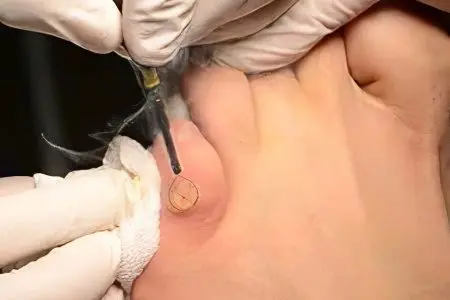
The radio wave method of removing calluses is an atraumatic coagulation of tissues. The impact on the skin growth is carried out with the help of thermal radiation. Its source is a thin electrode. The callus cells will simply evaporate.
With the help of radio waves, callus removal is painless. Healthy tissues will not be injured. The doctor does not put pressure on the dermis, does not have a mechanical effect on it. In parallel, the treated surface is disinfected, which prevents infection from entering the wound.
During the procedure, the person does not bleed. There is no direct contact of the electrode with the skin. The radio wave method eliminates the possibility of a burn, so that the wound heals very quickly.
The method has a number of contraindications, which include:
Acute infectious processes in the body.
Diabetes mellitus of decompensated form.
Hepatitis.
The presence of a pacemaker in the human body.
The advantages of the radio wave method for removing calluses include:
The speed of the procedure. You can get rid of the corn in a few minutes.
During the callus removal procedure, a person does not bleed.
Healthy tissues surrounding the corn will not be injured.
The rehabilitation process takes about 5 days, although the exact timing depends on the size of the skin growth.
The chance of complications is minimal. Infection of a wound is possible only if a person does not follow medical recommendations for caring for it.
The disadvantage of the procedure is the presence of contraindications to its implementation. If the patient has an increased pain threshold, then local anesthesia may be required.
After removing the corn, a crust forms in its place. You should not tear off the scab yourself, you also need to ensure that water does not get on the crust. For disinfection, it can be treated with brilliant green or Fukortsin. After a few days, it will fall off, and healthy young skin can be found under it. Subject to medical recommendations, it will be possible to avoid the re-formation of corns.
Surgical excision of calluses
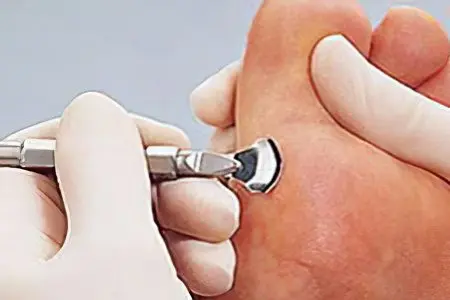
Surgical excision of corns is performed under local anesthesia. First, the doctor cuts off the top layer of the callus, and then excised it with a perpendicular incision. The penetration depth of the scalpel is 1 cm. The edges of the wound are cauterized with iodine solution.
The wound heals over 7-10 days or more.
This method is rarely used in modern cosmetology medicine, as it is highly traumatic. During the procedure, there is a possibility of bleeding and damage to healthy tissues, since the surgeon controls all actions manually. It will not be possible to do without anesthesia.
The advantage of surgical excision of calluses is the widespread availability of the method and the possibility of its free implementation in a state medical institution.
If the doctor does not completely remove the corn core, then after a while it may reappear. Therefore, excision should be as radical as possible.
After removing the build-up, the skin is treated with an antiseptic solution and the edges of the incision are fastened with an adhesive plaster. The rehabilitation period will be extended in time, especially if the doctor had to remove a large corn.
Medical treatment of corns
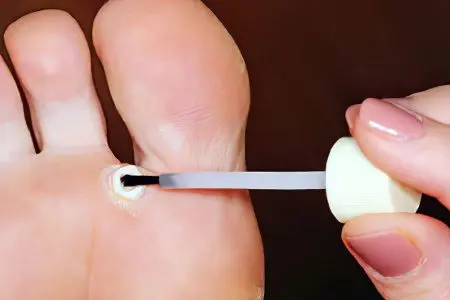
If the corn is small and has formed recently, then you can try to get rid of it with the help of medications.
These funds include:
Creams and ointments with salicylic acid. Their use allows you to systematically burn out the build-up from its bed. The course of treatment lasts about a month. Perform the imposition of Salicylic ointment 1-2 times a day. Beforehand, the legs need to be steamed.
Ointments and creams based on lactic acid.
Products based on sodium hydroxide. They allow you to get rid of corns due to its dissolution with alkali. They must be used very carefully, as they can lead to serious chemical burns.
With the help of conservative means, you can get rid of corns and superficial skin corns. If they have a rod, then such treatment will not give the desired effect, since the root of the growth is located in the depths of the tissues. You can get rid of it only with the help of surgical techniques.
When should you see a doctor?
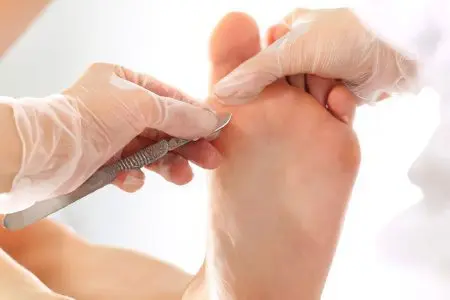
If dry skin corns do not give a person cause for concern, or are the cause of purely aesthetic discomfort, then you can deal with them at home, or visit a master who deals with hardware pedicure.
A doctor should be consulted for professional help if a person has the following problems:
The corn begins to hurt both at rest and while walking. The pain is sharp, reminiscent of lumbago.
The skin surrounding the corn becomes red, signs of inflammation appear.
The corn becomes cracked and bleeds.
The corn on the finger becomes inflamed, and the finger itself becomes blue.
Which doctor deals with the removal of corns?
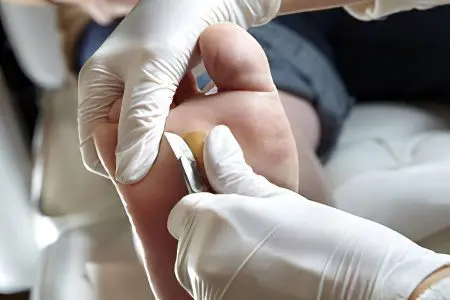
To get rid of the problem, you need to contact a dermatologist or a surgeon. In general, most medical centers are equipped with the equipment necessary to carry out the treatment of corns.
Sometimes pedicure masters with the appropriate qualifications are able to help cope with the problem.
The patient must understand that it is necessary to influence not only the corn itself, but also the cause that led to its occurrence. To do this, you need to consult a podiatrist or orthopedist. It is important to make sure that the foot has the correct anatomical structure, that the load on it is distributed correctly. Sometimes it happens that skin corns are the result of flat feet and even a fungal infection. In this case, a person needs professional treatment with drugs, and not just the removal of the corn itself.
Prevention of calluses on the feet
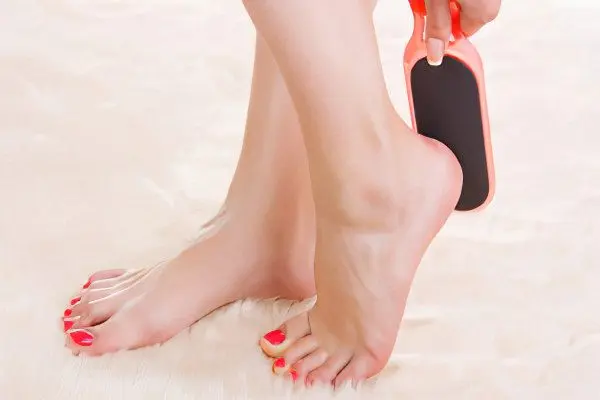
It is easier to prevent the formation of corns than to treat them later.
Preventive measures for skin growths on the legs can be as follows:
Shoes should be comfortable, made from natural materials and correct from an orthopedic point of view.
Socks and tights should not be synthetic. It is important to choose them by size.
If new shoes were put on and a long walk is ahead, then you need to take care of a replacement pair of shoes. You should always have a patch with you.
It is important to watch your weight. Extra pounds lead to excessive load on the lower limbs and can provoke the formation of calluses.
Foot hygiene should be regular. Every day, the feet should be washed with soap.
If a person’s feet are prone to hyperkeratosis, it is necessary to use moisturizing creams, or regularly undergo a hardware pedicure procedure.
Places of increased keratinization of the skin should be treated with pumice.
If a deformity of the foot is detected, it is necessary to contact an orthopedist.
Calluses that cause pain and aesthetic discomfort require treatment. There are many modern methods of their removal. Choose the most suitable and you need them together with a specialist.
Video: callus removal master class:









